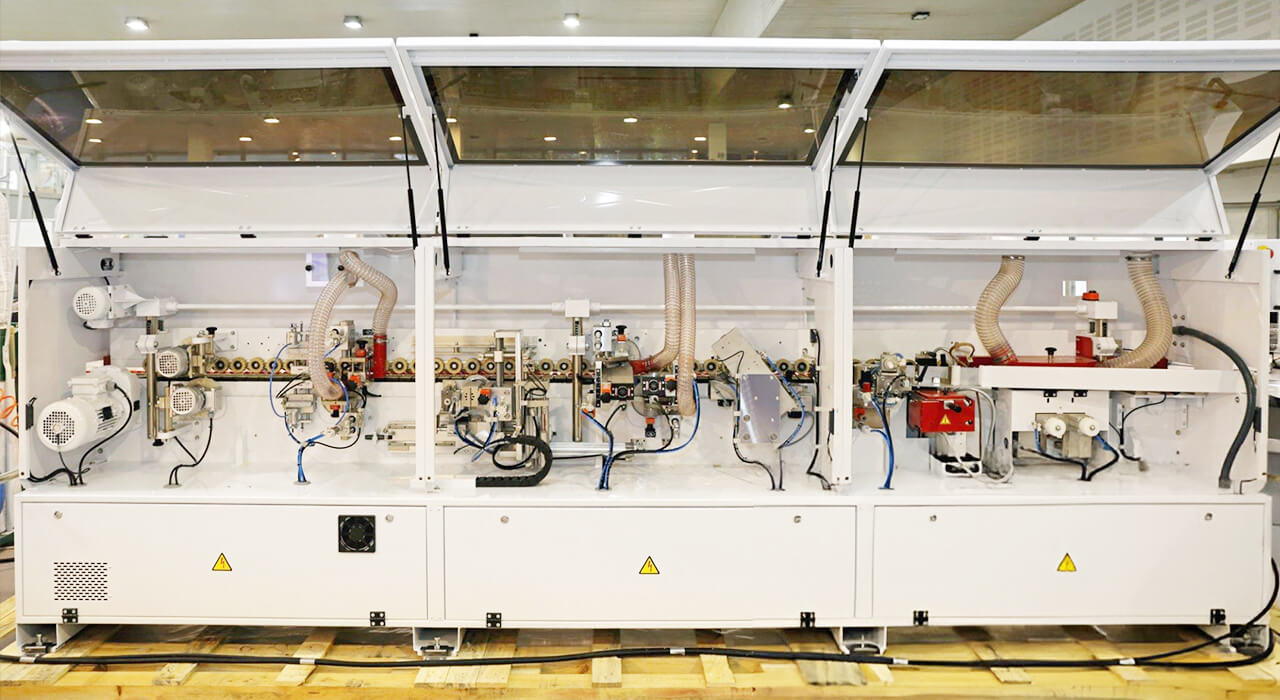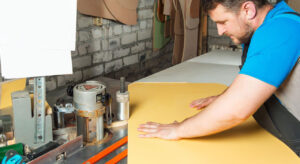Edge Banding is a vital finishing step in furniture manufacturing that delivers a polished, professional appearance and protects raw panel edges.
For medium and large factories, investing in an Industrial Edge Bander Machine means streamlined production and higher-quality results.
This guide will help you choose the Best Industrial Edge Bander Machine for your furniture factory.
Featured Resource
Table of Contents
1. What Is an Industrial Edge Bander Machine?
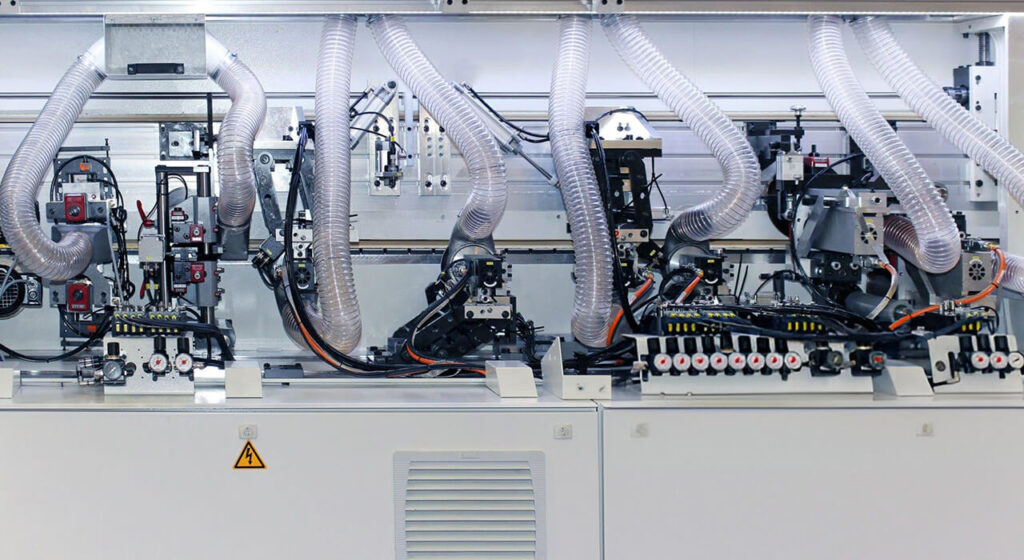
An Industrial Edge Bander Machine is a heavy-duty woodworking machine designed to apply and trim edgebanding material on panels automatically.
It applies adhesive and a thin strip (the edgeband) to cover and seal the exposed sides of boards like MDF, particleboard, or plywood. These machines often include trimming, scraping, and buffing units to finish the edges neatly. Industrial models are built for high-volume production, handling heavy usage at fast rates.
2. Why Edge Banding Matters in Furniture Production
Edge Banding plays a crucial role in furniture manufacturing. It can give your final furniture a refined look and improved durability. Without edge banding, panels have rough or exposed edges that are prone to chipping, moisture penetration, and visual imperfections.
In practical terms, by edge banding, your cabinets, shelves, and tabletops will look seamless and stand up to everyday use.
It is especially important in protecting high-humidity or heavy-use areas (like kitchens or bathrooms) where untreated particleboard edges would quickly degrade.
An industrial edge bander machine transforms raw panels into finished components, combining strength, function, and style in one automated pass.
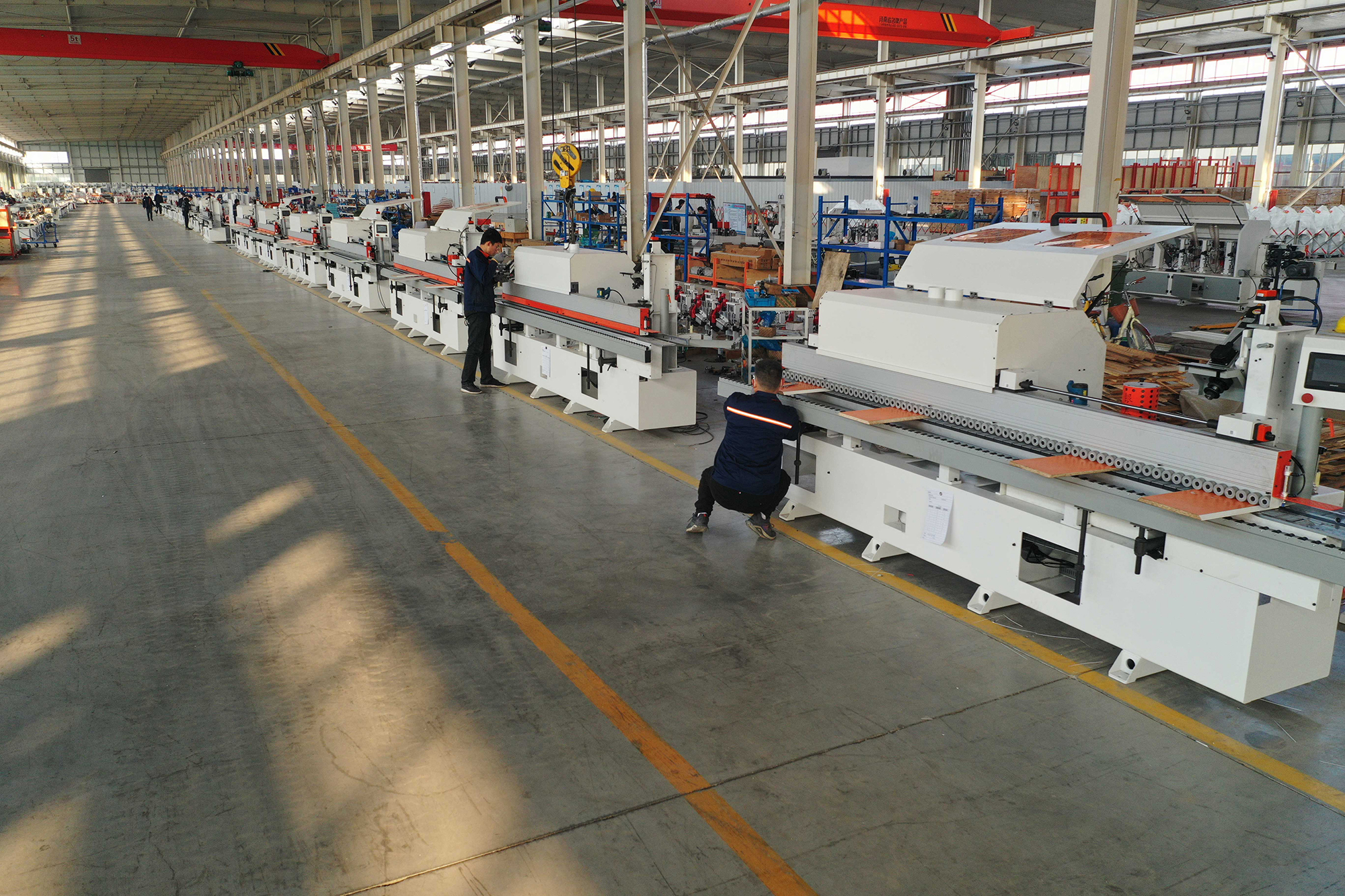
3. Three Types of Industrial Edge Bander Machine
In general, there are three models of Industrial Edge Bander Machine for furniture owners’ choice.
3.1. EVA Edge Banding Machines
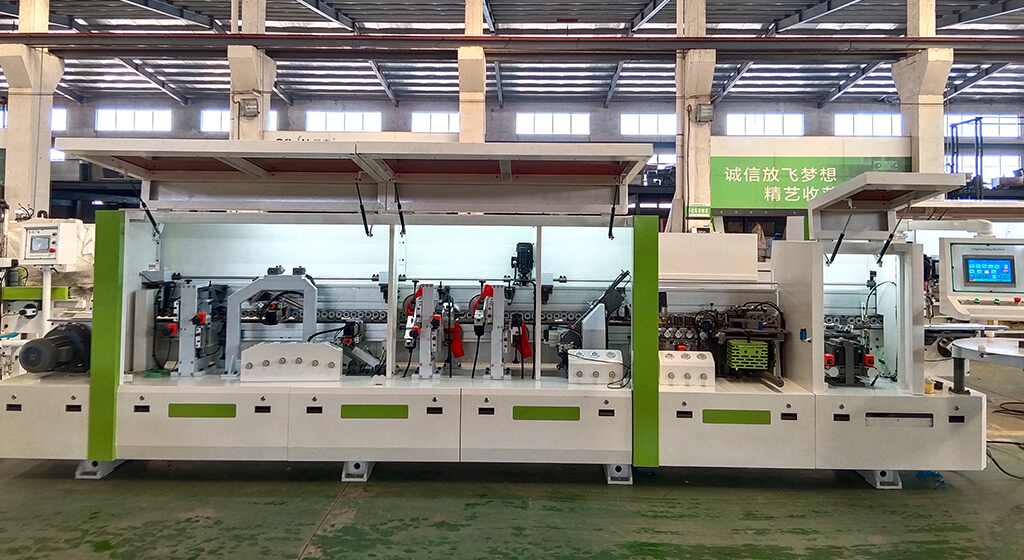
EVA (ethylene-vinyl acetate) Edge Banders use a conventional hot-melt glue pot to apply EVA adhesive between the panel and edge tape. The machine heats EVA granules until molten, coats the tape or panel, then presses the tape onto the workpiece. This simple setup makes EVA banders common in industrial settings.
| Aspect | Pros | Cons |
|---|---|---|
| Cost | Very low equipment and adhesive cost | – |
| Ease of Use | Simple to operate; no special skills or setup required | – |
| Speed | High initial tack enables fast line speeds | – |
| Compatibility | Works with standard PVC/ABS edge banding tape | – |
| Production Efficiency | Quick-setting for high throughput in industrial settings | – |
| Bond Strength | – | Limited strength and durability |
| Glue Line Thickness | – | Thick seam (about 0.1–0.2 mm), often visible |
| Heat/Moisture Resistance | – | Poor resistance; bond may weaken or fail in hot or humid conditions (e.g. kitchens, baths) |
| Aesthetic Quality | – | Visible glue lines; prone to discoloration (yellowing) |
| Long-Term Performance | – | Can delaminate or develop mildew over time |
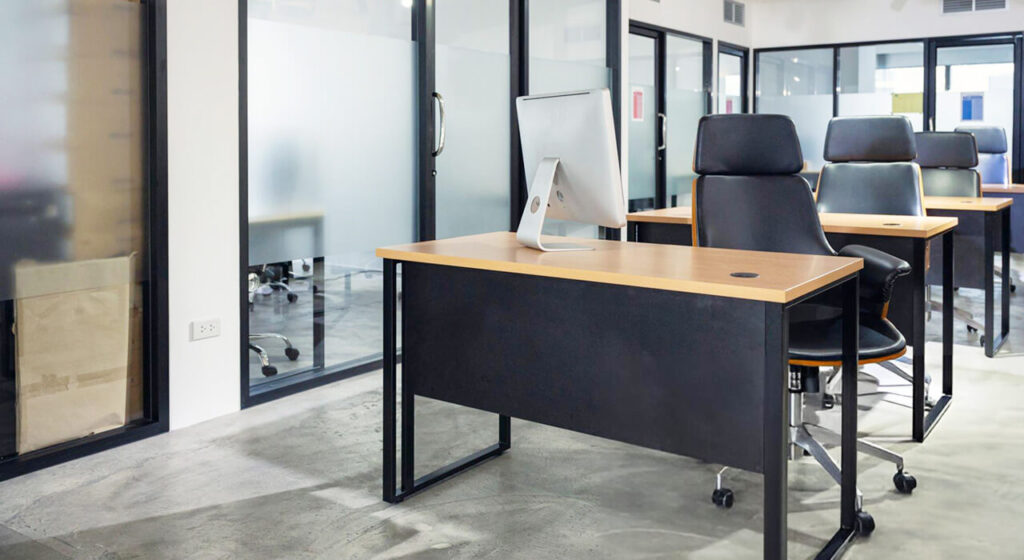
- Ideal Use Cases: Budget-sensitive production of standard furniture (simple cabinets, shelving, economy office units, etc.) in controlled indoor environments. EVA banders suit high-volume runs where edge appearance and longevity are secondary to cost. They are widely used when an industrial edge bander machine must maximize output with minimal glue expense.
-
Cost & Maintenance: Both machines and consumables are inexpensive. EVA adhesive costs roughly ¥10–30/kg, and EVA bander prices are at the low end of industrial banders. However, EVA uses more glue (200–300 g/m²), increasing material waste and cleanup.
3.2. PUR Edge Banding Machines
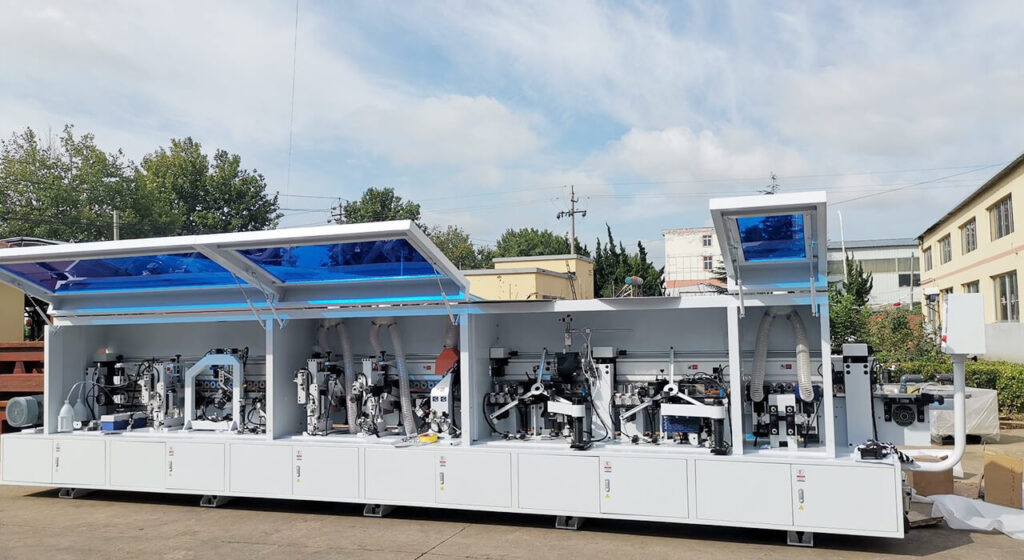
PUR (polyurethane reactive) industrial Edge Bander Machine also use hot-melt glue but with a moisture-cure polyurethane. The machine melts PUR granules (typically 130–150 °C) and applies a thin, reactive coating. As the assembly cools, ambient moisture triggers a chemical cross-linking, creating a tough thermoset bond.
| Aspect | Pros | Cons |
|---|---|---|
| Bond Strength | Extremely strong, durable bonds; high peel strength (>140 N) | – |
| Seam Appearance | Very thin glue line (≈0.03–0.05 mm); nearly invisible joint | – |
| Moisture & Heat Resistance | Excellent resistance to water, steam, and heat | Requires stable humidity for proper curing |
| Chemical Resistance | Resistant to yellowing, swelling, and chemical attacks | Sensitive to surface contaminants |
| Indoor Air Quality | Formaldehyde-free; E0 compliant | – |
| Ideal Applications | High-humidity areas like kitchen cabinets and bathroom vanities | – |
| Production Quality | Enhances product longevity and finish | – |
| Adhesive Cost | – | 3–5× higher than EVA glue (≈¥55–75/kg) |
| Machine Cost | – | Higher due to PUR-specific components (glue pot, pump, etc.) |
| Operation & Maintenance | – | Requires periodic cleaning and proper storage of glue system |
- Ideal Use Cases: Mid-to-large factories making premium or moist-environment furniture (high-end cabinets, office fixtures, built-ins). PUR banders are preferred when long-term durability and appearance are critical. They suit customers demanding superior edge quality and resistance (e.g. commercial or outdoor-adjacent furnishings).
-
Cost & Maintenance: While PUR glue is costly, much less is used (only 70–150 g/m²). Over large production volumes, the higher unit cost is offset by far fewer reworks and replacements. PUR machines require regular cleaning of the glue pot and applicator, but they tend to last longer between major repairs. In the long run, factories often save on warranty claims, making PUR a better ROI for quality-focused operations.
3.3. Laser Edge Banding Machines
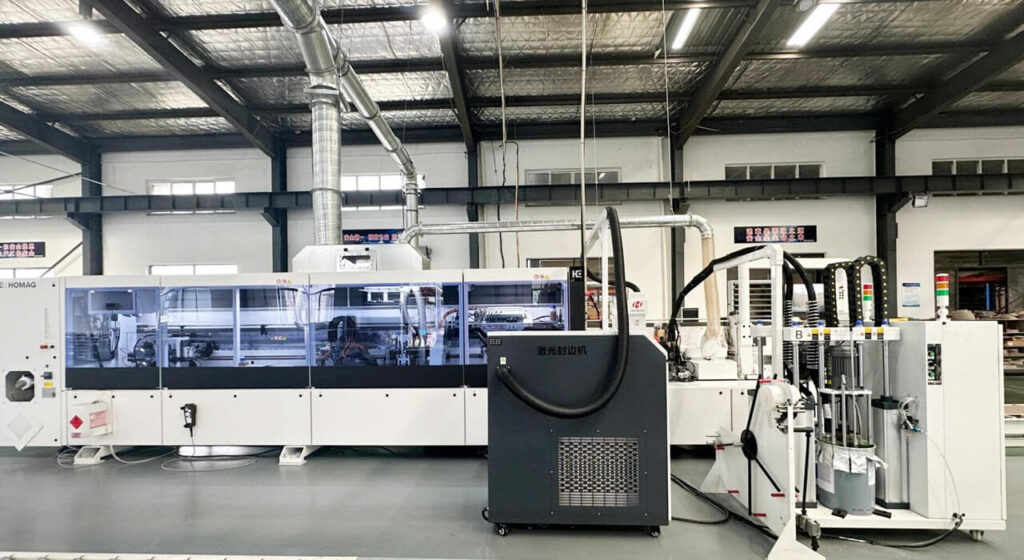
Laser Edge Banding Machines forgo traditional glue. Instead, the edge tape is pre-coated with a special reactive layer.
A focused infrared laser beam (typically ~980 nm) scans the tape, melting its functional layer (about 0.2 mm thick) at 500–800 °C, and then the tape is pressed onto the panel. This process creates a direct thermoplastic bond with no separate adhesive.
| Aspect | Pros | Cons |
|---|---|---|
| Edge Quality | Perfectly seamless edges with a Zero Joint Finish | – |
| Aesthetics | No trimming marks; ideal for high-end furniture | – |
| Health & Environment | No glue = no fumes or volatile organic compounds (VOCs) | – |
| Glue Usage | No need for EVA or PUR adhesives | – |
| Tape Requirements | – | Requires special laser-ready tape (~¥3–5/m vs <¥1/m for standard tape) |
| Machine Cost | – | Extremely expensive — 10–20× cost of standard edge banders (multi-million RMB range) |
| System Requirements | – | Needs stable power, cooling systems, precise laser optics, and controlled environment |
| Maintenance | – | Requires specialist technicians for setup and maintenance |
| Application | Excellent for premium, high-precision cabinetry | May be cost-prohibitive for small to medium workshops |
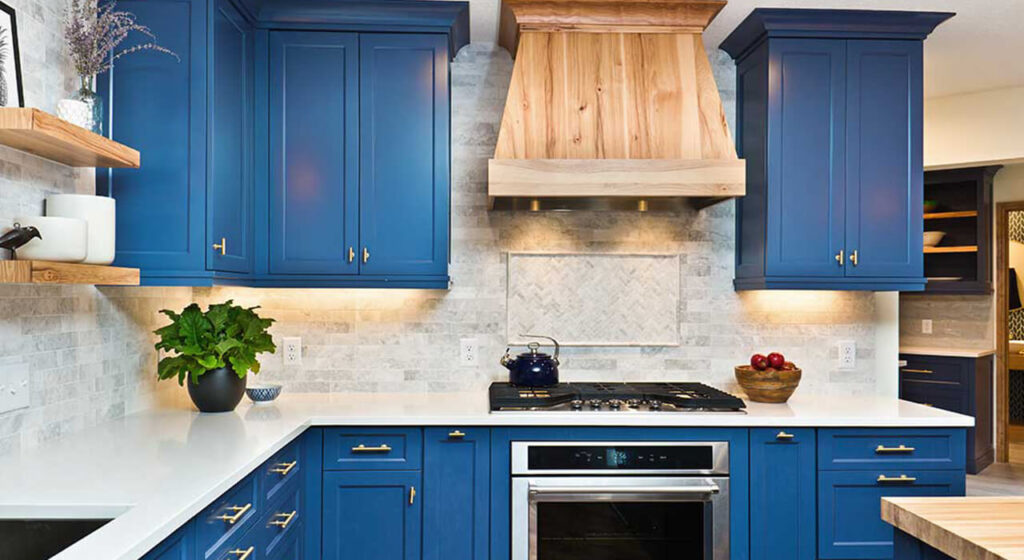
- Ideal Use Cases: Top-tier furniture makers and custom shops where edge perfection commands a premium. Laser banders suit luxury kitchens, boutique cabinetry and design-forward interiors where clients expect flawless, maintenance-free edges. Large manufacturers investing in maximum differentiation (and able to recoup cost via higher margins) may adopt lasers.
-
Cost & Maintenance: The upfront capital and tape cost are by far the highest. However, no glue handling or cleanup is needed day-to-day. Maintenance is specialized (laser calibration, optics cleaning, coolant system checks). Given the expense, factories using laser banders must ensure very high utilization or sell into premium markets. Only large industrial volumes or very high-value products typically justify a laser edgebander.
4. Industrial Edge Bander Machine Fuction
When selecting the right Industrial Edge Bander Machine, it’s not just about glue type (EVA, PUR, laser)—it’s also about what the machine can do. Here’s a breakdown of the main functions and why they matter in your production line:
4.1. Pre-Milling
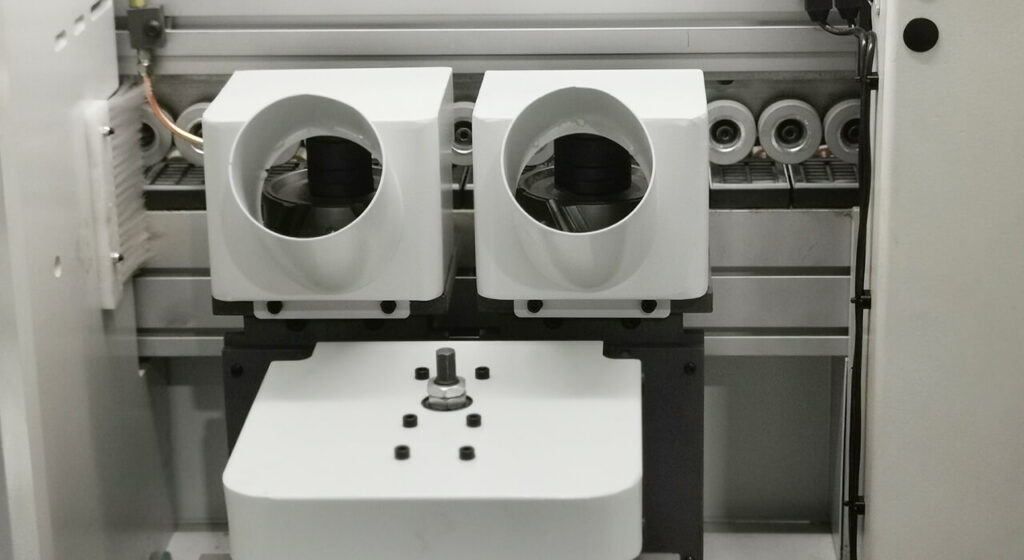
Purpose: Cleans and smooths the panel edge before gluing.
Why it matters: Removes imperfections like chips, fiber tear-out, or panel warping. It ensures the tape adheres to a flat, clean surface, reducing delamination risk. Especially useful for MDF, plywood, or laminated particle boards.
Benefit: Boosts glue bond strength and edge alignment.
4.2. Gluing Station (EVA or PUR)
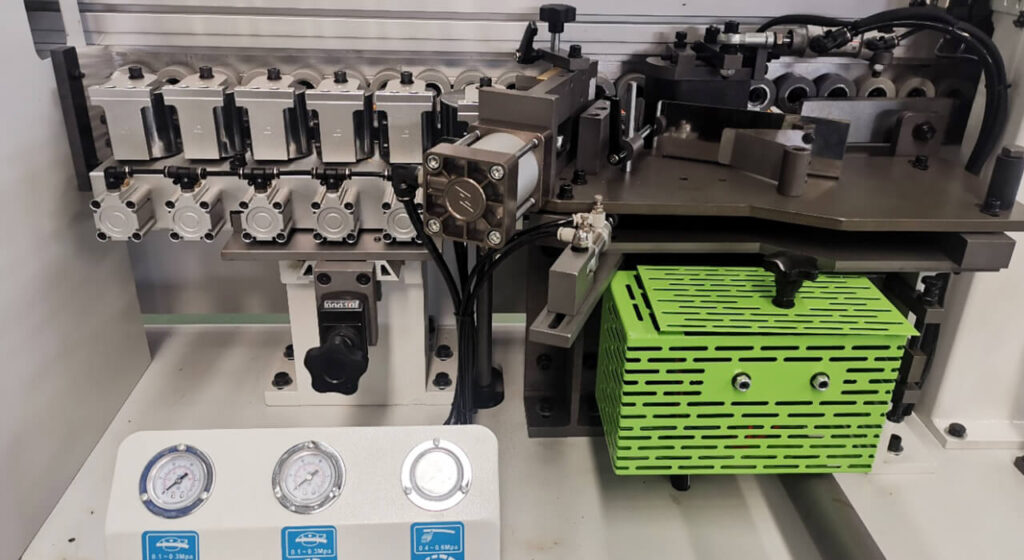
Purpose: Heats and applies adhesive (EVA or PUR) to the panel edge.
Why it matters: Determines bond durability. Modern systems control glue temperature and flow with precision rollers or slot nozzles. PUR systems require sealed tanks, while EVA uses a glue pot.
Benefit: Provides strong, consistent adhesion throughout your production shift.
4.3. Edgeband Application (Pressure Section)
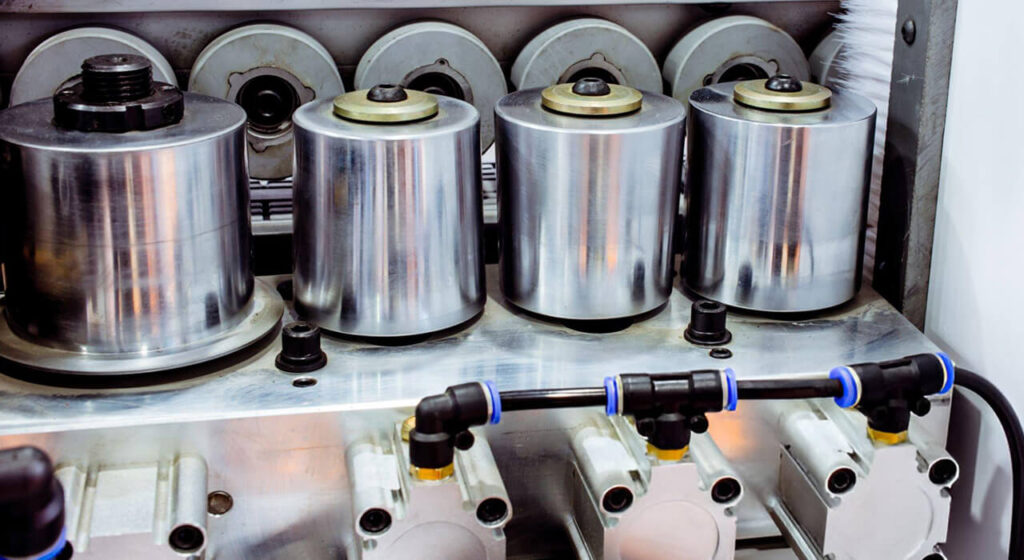
Purpose: Presses edge tape (PVC, ABS, wood veneer) onto the panel.
Why it matters: Ensures no air gaps or slippage during high-speed operation. Pressure rollers are adjusted to different tape types and thicknesses.
Benefit: Delivers seamless contact and eliminates human error.
4.4. End Cutting (Front/Rear Trimming)

Purpose: Cuts off the excess tape at the panel’s front and rear ends.
Why it matters: Sharp, synchronized saw blades trim the tape flush, preventing overhangs or chipping that affect panel alignment.
Benefit: Results in perfectly squared panel ends.
4.5. Top and Bottom Trimming
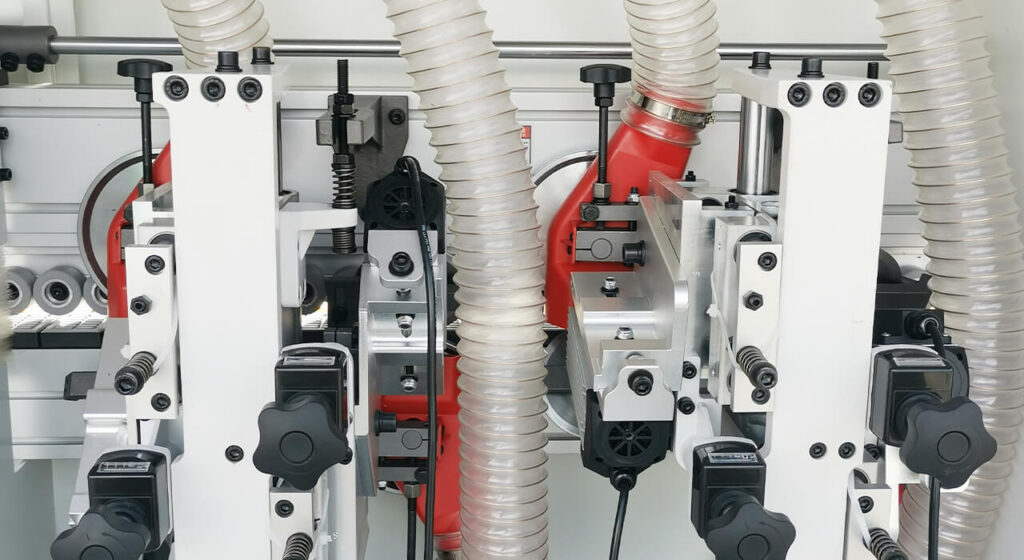
Purpose: Trims the top and bottom tape flush with the panel surface.
Why it matters: High-speed rotating knives ensure smooth tape leveling, whether it’s thick PVC or thin melamine. Most machines offer radius and bevel trimming options.
Benefit: Provides clean, smooth panel edges with no protrusions.
4.6. Corner Rounding (Corner Trimming)
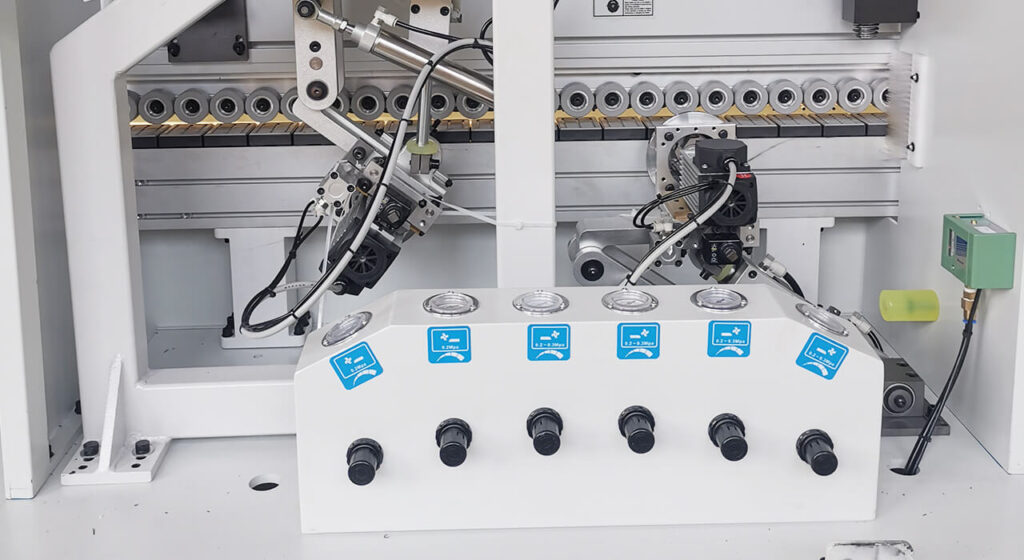
Purpose: Rounds the front and rear corners of the top and bottom edges.
Why it matters: Prevents sharp corners and improves aesthetics and safety. Ideal for curved, soft-edged, or premium furniture.
Benefit: Delivers a high-end, ergonomic finish that clients love.
4.7. Scraper Unit

Purpose: Scrapes off excess glue and tape residue after trimming.
Why it matters: Enhances visual appearance by smoothing minor imperfections, especially on PVC tape with radius trimming.
Benefit: Creates a flawless, seamless glue line.
4.8. Buffing/Polishing Unit
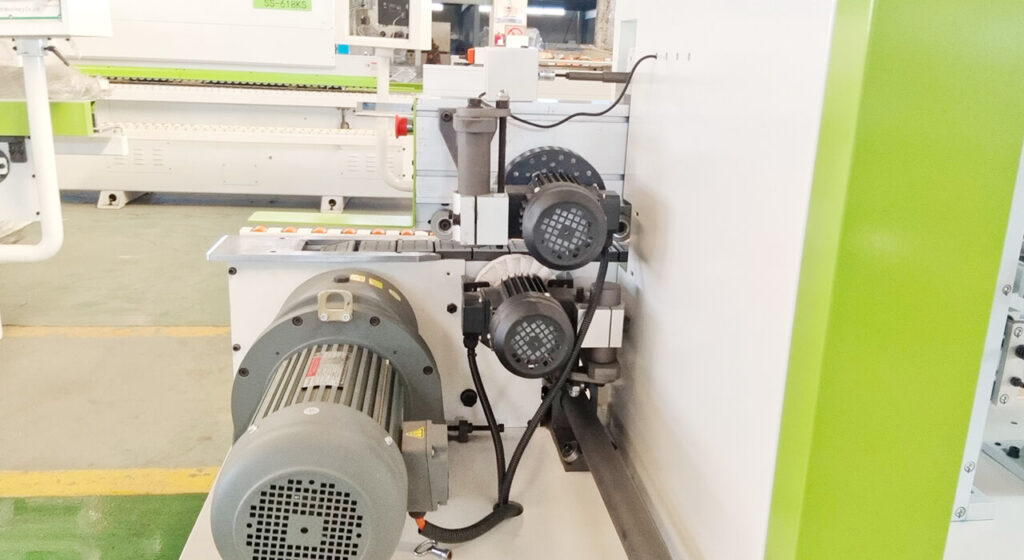
Purpose: Uses rotating fabric wheels to polish the edge.
Why it matters: Restores shine and removes fine dust or scratches. It’s the final touch to give your panel a professional-grade look.
Benefit: Adds brilliance and polish to your finished product.
4.9. Dust Extraction & Cleaning
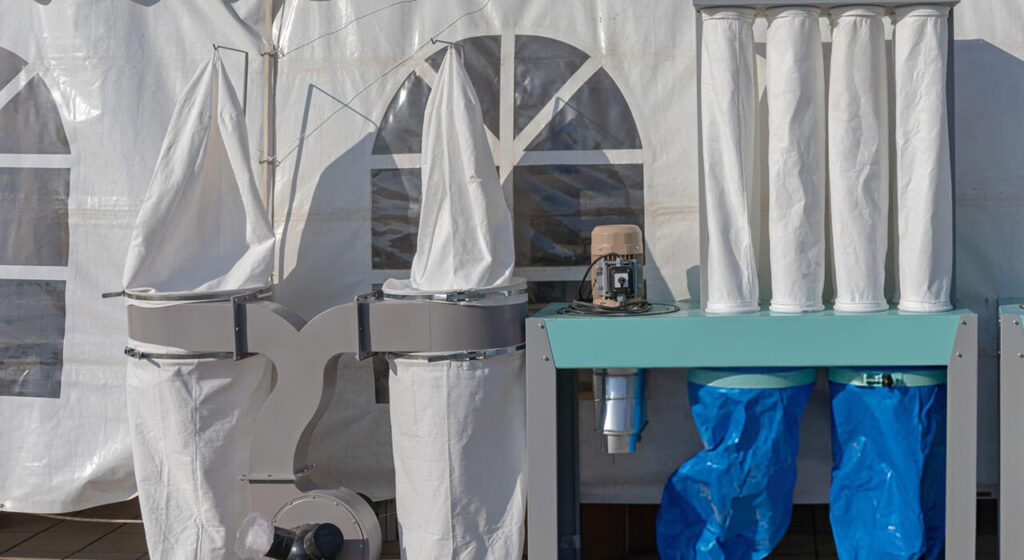
Purpose: Uses rotating fabric wheels to polish the edge.
Why it matters: Restores shine and removes fine dust or scratches. It’s the final touch to give your panel a professional-grade look.
Benefit: Adds brilliance and polish to your finished product.

5. Key Factors When Choosing an Industrial Edge Bander Machine
Selecting the right edge bander involves evaluating several technical and business factors. Key considerations include:
-
Speed (Throughput): The feed speed determines how many panels you can edge-band per minute. Typical industrial edgebanders run from about 5–25 m/min. Recommended speeds vary by edge material – for example, PVC edges often run best at 15–20 m/min, while solid wood veneers may require slower rates (8–12 m/min).
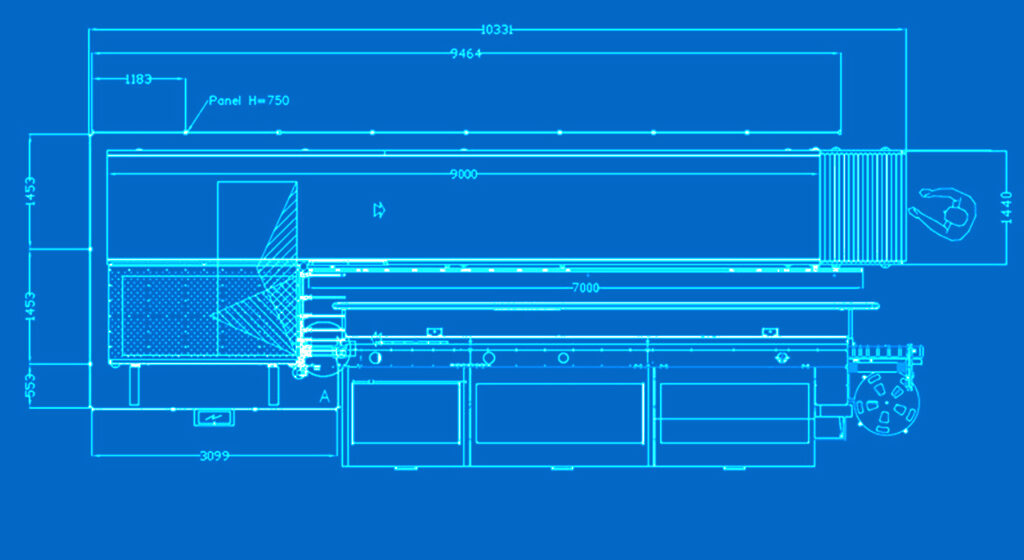
Machine Footprint & Space: Consider the physical size and layout of the bander. Industrial edge banders can be very large. Account for the machine’s overall length (including infeed and outfeed conveyors) and the clearance above for tall panels. Ensure there’s room for operators to move safely around the machine, for maintenance access, and for accessories like dust collectors and return conveyor.
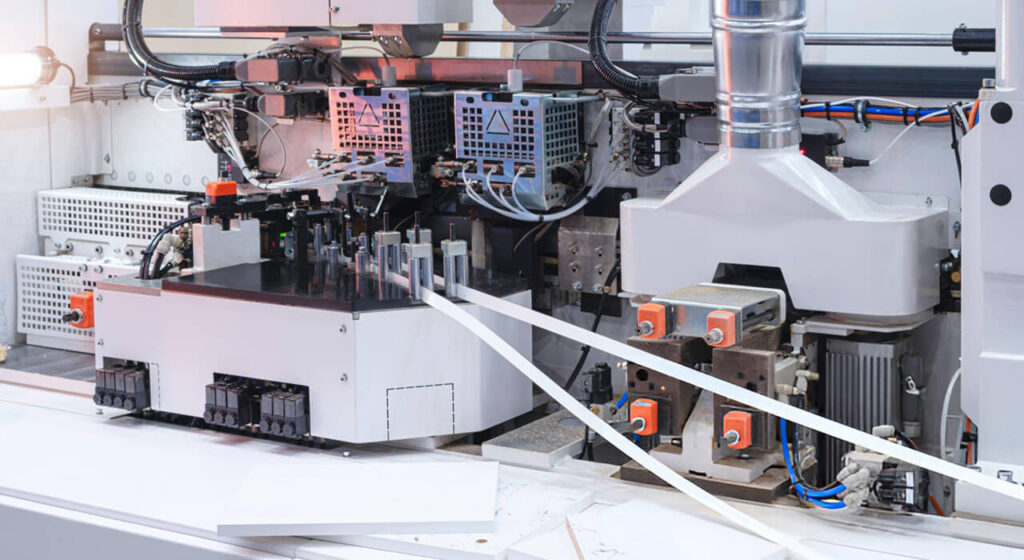
- Glue/Adhesive Type: The type of glue system affects bond strength and operation. Common glue types include hot-melt (EVA), EVA/PUR, and pure PUR (polyurethane) systems. Some advanced machines support multiple adhesive systems or dual glue pots.
- Edge Thickness Range: Verify the thickness range of edgeband tape the machine supports. Standard models typically handle about 0.4–3 mm tape, but heavy-duty banders can process much thicker trim.
- Material Compatibility: Make sure the bander can process your panel substrates and edge materials. Most industrial machines work with panels of MDF, plywood, particle board, and melamine-laminate. Some advanced models can also apply banding to specialty panels like polymer (PVC) boards or aluminum honeycomb.
- Maintenance & Care: A well-maintained bander runs longer and more reliably. Operators should inspect the machine daily for glue spills, dust buildup, or unusual noise. Keep critical spares (like glue nozzles and knives) on hand to avoid downtime.
6. To Sum Up
Industrial Edge Bander Machine are essential for boosting a company’s efficiency and productivity. Having one may significantly increase your output and revenue.
Ready to boost your production? Contact us today to discuss your needs.
Ask about scheduling a demonstration or visiting a factory to see machines in action. Investing in the right Industrial Edge Bander Machine is investing in your factory’s future.



